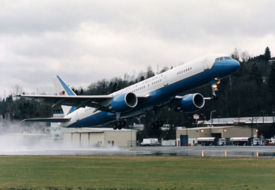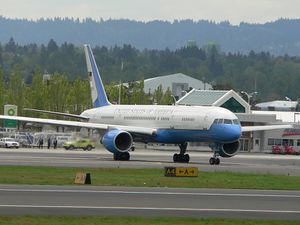PlaneSpottingWorld welcomes all new members! Please gives your ideas at the Terminal.
Boeing C-32
| Boeing C-32 | |
|---|---|
| A C-32 taking off from Boeing Field | |
| Type | VIP transport |
| Manufacturer | Boeing |
| Introduced | June 1998 |
| Status | Operational |
| Primary user | U.S. Air Force |
| Number built | 4 |
| Developed from | Boeing 757-200 |
The Boeing C-32 is the designation of a United States Air Force passenger transportation aircraft, a military version of the Boeing 757.
The C-32 provides safe, comfortable and reliable transportation for United States leaders to locations around the world. The primary customers are the Vice President of the United States, using the distinctive call sign "Air Force Two," the First Lady, and occasionally members of the U.S. Cabinet and U.S. Congress. Both President George W. Bush and Bill Clinton have at times used a C-32 as Air Force One in place of the larger and less efficient VC-25A; the C-32 also has better short-field capacity than the VC-25, making it preferable when flying to locations without a runway long enough to accommodate the Boeing 747-derived VC-25.
Contents
Background
The C-32 is a military version of the Boeing 757-200 extended range aircraft, selected along with the C-37A to replace the aging fleet of C-137 aircraft. Active-duty aircrews from the 1st Airlift Squadron, 89th Airlift Wing at Andrews Air Force Base, Md., fly the aircraft.
The contract was awarded for the C-32 in August 1996. By using commercial off-the-shelf acquisition practices, a new record has been set from contract award to aircraft delivery: less than two years. The C-32 is the first military aircraft ever acquired in this manner. The 89th Airlift Wing acquired the first of four aircraft in late June 1998.
Features
The C-32 is a specially configured version of the Boeing 757-200 commercial intercontinental airliner. The C-32 body is identical to that of the Boeing 757-200, but has different interior furnishings and more sophisticated avionics. The passenger cabin is divided into four sections:
- The forward area has a communications center, galley, lavatory and 10 business-class seats.
- The second section is a fully enclosed stateroom for the use of the primary passenger. It includes a changing area, private lavatory, separate entertainment system, two first-class swivel seats and a convertible divan that seats three and folds out to a bed.
- The third section contains the conference and staff facility with eight business-class seats.
- The rear section of the cabin contains general seating with 32 business-class seats, galley, two lavatories and closets.
As the C-32 is a high-standing aircraft, it is easier to see under and around it. This is an important security factor for protecting the plane and its passengers.
The C-32 is more fuel efficient and has improved capabilities over its Air Force One C-137/B-707 predecessor. It can travel twice the distance on the same amount of fuel, and operate on shorter runways down to 5,000 feet (1,500 m) in length. Its 92,000 pound (41,700 kg) fuel capacity allows the aircraft to travel 5,500 nautical miles (10,000 km) unrefueled.
Heading the safety equipment list is the Traffic Collision Avoidance System and Enhanced Ground Proximity Warning System that gives advance warning of possible air and ground threats. Weather systems are enhanced with a Predictive Windshear Warning System. Other items include the future air navigation system with Global Positioning System and Flight Management System/Electronic Flight Instrument System.
Inside the C-32, communications are paramount. The Vice President, heads of state and other decision-makers can conduct business anywhere around the world using improved telephones, satellites, television monitors, facsimiles and copy machines. The C-32 has state-of-the-art avionics equipment.
Operators
Specifications (C-32A)
General characteristics
- Crew: 16 flight crew (varies with mission)
- Capacity: 45 passengers
- Length: 155 ft, 3 in (47.32 m)
- Wingspan: 124 ft, 8 in (37.99 m)
- Height: 44 ft, 6 in (11.02 m)
- Max takeoff weight: 255,000 lb (115,700 kg)
- Powerplant: 2× Pratt and Whitney 2040 engines, 41,700 lbf (184 kN) each
Performance
- Maximum speed: 530 mph (Mach 0.8) (850 km/h)
- Range: 5,500 nautical miles unrefueled (10,186 km)
- Service ceiling: 42,000 ft (12,727 m)
External link
- The original version of this article was from the public domain source at Air Force Link
- As to the 2007 Pelosi controversy, see http://www.cnn.com/2007/POLITICS/02/09/pelosi.plane/index.html
Related content
Related development
Comparable aircraft
Designation sequence
C-29 - C-30 - C-31 -
C-32 - C-33 - UC-35 - YFC-36
Related lists
Lists relating to aviation | |
|---|---|
| General | Timeline of aviation · Aircraft · Aircraft manufacturers · Aircraft engines · Aircraft engine manufacturers · Airports · Airlines |
| Military | Air forces · Aircraft weapons · Missiles · Unmanned aerial vehicles (UAVs) · Experimental aircraft |
| Notable incidents and accidents | Military aviation · Airliners · General aviation · Famous aviation-related deaths |
| Records | Flight airspeed record · Flight distance record · Flight altitude record · Flight endurance record · Most produced aircraft |


